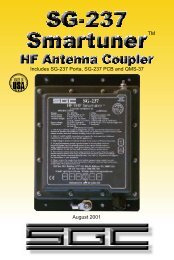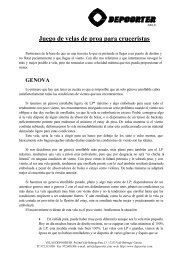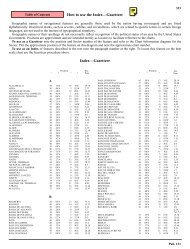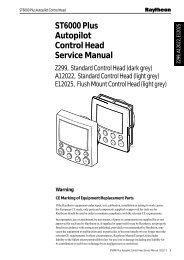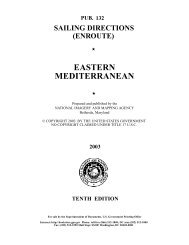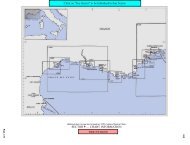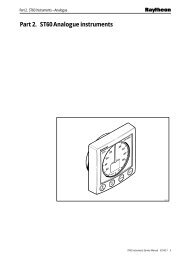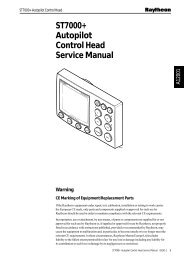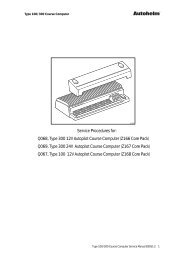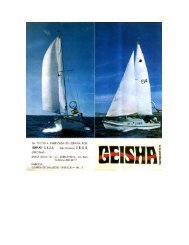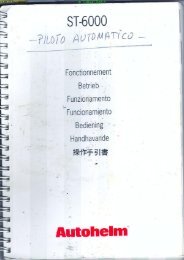Autohelm Inboard Autopilots (ST6000 and ST7000 systems) Service ...
Autohelm Inboard Autopilots (ST6000 and ST7000 systems) Service ...
Autohelm Inboard Autopilots (ST6000 and ST7000 systems) Service ...
- No tags were found...
Create successful ePaper yourself
Turn your PDF publications into a flip-book with our unique Google optimized e-Paper software.
<strong>Autohelm</strong>3.3 Operating HintsResponse Level AdjustmentThe <strong>ST6000</strong> has three response levels whichenable tighter course keeping to be achieved incertain cases:-Level 1 - Automatic Sea State ControlLevel 2 - Automatic Sea State InhibitLevel 3 - Automatic Sea State Inhibit <strong>and</strong>counter rudder.When the autopilot is switched on, the responselevel is set to 1. This provides the bestcompromise between power consumption <strong>and</strong>course keeping accuracy <strong>and</strong> is suitable fornearly all situations.Increasing Response level provides tightercourse keeping at the expense of increasedpower consumption <strong>and</strong> general wear <strong>and</strong> tear.It is advisable to use the minimum responselevel necessary to achieve the desired coursekeeping accuracy. On larger power vesselslevel 3 can improve slow speed steering wherethe natural yaw damping of the vessel isreduced.Note: Level 3 is not recommended for use atplaning speeds or in rough seas.TrackTo make full use of Track control the followingsimple points should be observed:-• Always steer the vessel to within 0.1nm oftrack <strong>and</strong> bring the heading to within 5° of thebearing to the next waypoint before selectingTrack.• Always check that there are no navigationalhazards either side of the intended track.• Always maintain an accurate log withregular plots to verify the computed positionread from the Radio Navigation Receiver.• Maintain a proper lookout at all times.•Waypoint AdvanceIf the navigation receiver is transmitting thewaypoint number to the <strong>ST6000</strong> the waypointalarm will sound whenever a new targetwaypoint is selected (see Page 9). When thealarm is sounding the <strong>ST6000</strong> will maintain thecurrent heading <strong>and</strong> automatic track control issuspended. Check the displayed new bearing towaypoint <strong>and</strong> when it is safe to turn onto it,resume automatic track control by simplypushing Track.This accepts the new target waypoint <strong>and</strong> willsteer the vessel onto the new bearing towaypoint.The tidal offset may be very different on the newbearing, <strong>and</strong> it is good practise to check thecross track error after a couple of minutes. If thecross track error continues to increase make acourse adjustment of say 10 degrees in thedirection of the arrow. This will help the Trackcontrol correct more quickly for the new tidalvector.Automatic TrimIf Automatic Trim has been selected duringcalibration the <strong>ST6000</strong> will correct for trimchanges. This correction can take up to oneminute to apply the rudder offset necessary torestore the set automatic heading. Large coursechanges which change the apparent winddirection, can produce large trim changes. Inthese cases the autopilot will not immediatelyassume the new automatic heading, <strong>and</strong> onlysettle onto course when the Automatic Trim hasbeen fully established.To minimise the inherent time delay thefollowing procedure may be adopted for largecourse changes.• Note required new heading.• Select St<strong>and</strong>by <strong>and</strong> steer manually.• Bring vessel onto new heading.• Select Auto <strong>and</strong> let vessel settle ontocourse.• Bring to final course with 1° increments.It is sound seamanship to make major coursechanges only whilst steering manually. In thisway any obstructions or other vessels may becleared properly <strong>and</strong> due account taken of thechanged wind <strong>and</strong> sea conditions on the newheading prior to engaging the autopilot.Rudder GainThe rudder gain level selected during initial seatrials will normally provide excellent steeringperformance over a wide range of conditions.However, it may be noticed that the autopilottends to be a little less stable on northerlyheadings in the higher latitudes of the northernhemisphere (<strong>and</strong> conversely southerly headingsin the southern hemisphere). This is caused bythe increasing angle of dip of the earth's12SeaTalk <strong>Service</strong> Manual



